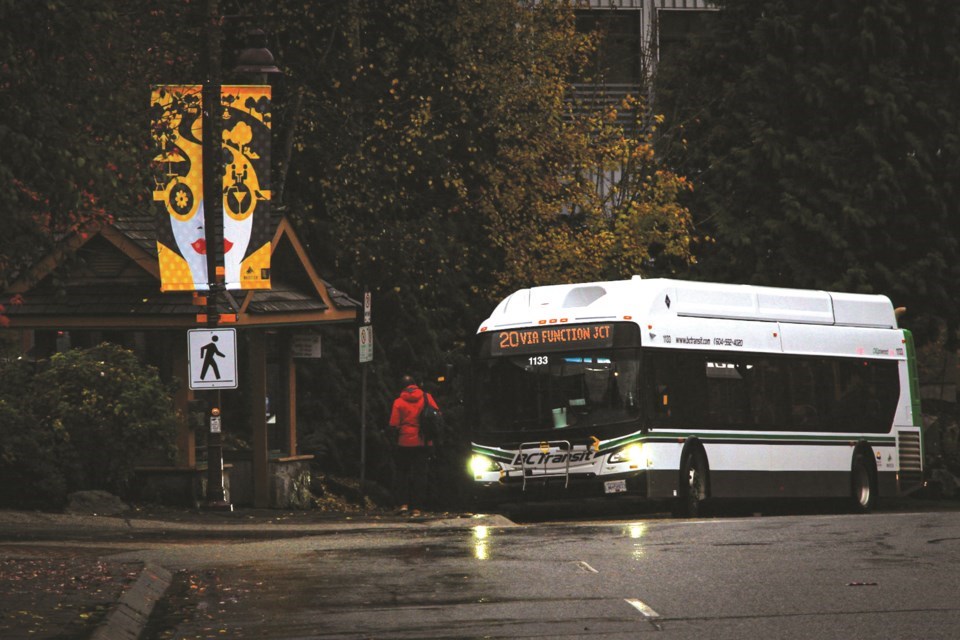The province's newly-created “Transit Oriented Development Areas” (TOD Areas) won’t make too much of a splash in Whistler, with only the village’s Gondola Exchange receiving the designation.
Under new provincial legislation, municipalities must alter their bylaws to allow for greater housing density near transportation hubs, with all municipalities being assessed and alerted by the province of where in their borders they have transportation hubs that meet provincial criteria.
For Whistler, that’s the Gondola Exchange, on Blackcomb Way—which is the heart of Whistler’s transit network with 14 routes stopping there. Of the entire network, only the 10 (which goes from Emerald Estates to Cheakamus Crossing) does not go to the Gondola Exchange.
Under changes adopted June 25, the Gondola Exchange is now the centre of a cluster of density bylaws that set the minimum allowable height of residential development at six storeys for developments within 200 metres, and four storeys for developments between 200 and 400m. All parcels of land that are wholly or partially within the 200 and 400m radius of the Gondola Exchange fall under the new bylaws. The municipality must adhere to these new minimums when considering rezoning applications.
“In TOD Areas, local governments cannot deny rezoning applications on the basis of height or density if they are within the minimum allowable amount,” said RMOW planner Joanna Rees in presenting to council.
“Eligible sites within the TOD Area must be zoned for all or partial residential use,” she added.
Also under the provincial requirements, which are laid out in Bill 47, the municipality is now barred from requiring off-street parking for residential developments within the TOD Area—meaning developers can choose to not include residential parking, and the municipality would be unable to force them to. Developers could still voluntarily include parking in the developments should they choose, while parking associated with non-residential developments still apply.
Any applications within the TOD Area would follow the same standard rezoning process, with the only difference being council wouldn’t be able to reject the application based on height or density if they were within the minimum allowable metrics.
Following the presentation, Councillor Cathy Jewett noted the village’s Gateway Loop fell outside of the “bull's-eye” that was the TOD Area coordinates the RMOW was provided by the province, and asked why the loop was not considered a TOD Area of its own.
In response, Rees said the province used set criteria to identify the Gondola Exchange, and the RMOW received direction that did not include the Gateway Loop.
“The criteria includes 15-minute service frequency, to a more unique line and route connections, service seven days a week between 7 a.m. and 7 p.m., one route meeting minimum frequency of at least 12 hours per day, and permanent purpose-built infrastructure,” she said.
Jewett was not discouraged by that criteria, and continued her line of thought.
“I could just see though, given [the Gateway Loop] is a major hub of transportation, that it could be considered, especially the fact we have a lot of people coming up the highway on buses.”
What did fall inside the TOD Area set by the province also came under question from Jewett, who asked if staff knew how much of the radius area was in a floodplain.
“It looks to me like a lot of it is within the day skier parking lots, which are part of a floodplain,” she said, going on to speak about what else was within the radius such as parts of ski runs.
“I’m just curious about the potential, because for me I see it as pretty difficult land to take advantage of,” she said.
Rees responded that for parcels to qualify, they would have to be zoned for partial or all residential use, ruling out lands such as those under Whistler Blackcomb's tenure.
Rees later said the RMOW had done a preliminary review of the parcels within the TOD Area, and “the majority of them don’t have residential uses, but at this time it's difficult to speak towards what the redevelopment potential or the interest in uptake would be.”
Coun. Jeff Murl picked up Jewett’s comments, saying the Gateway Loop had “all the same amenities as [the Gondola Exchange] does, and seems like it includes a lot more opportunity than Gondola Exchange, has anyone ever said this is a better TOD?”
He was told by head of planning services, Dale Mikkelson, that given timelines from the province, and that the TOD Areas were assigned by the province, the RMOW was doing what it was asked.
“There could be a time in the future if a municipality decided they wanted to apply those rules to a different location, you could identify that to the province,” he said.
“But right now, the designated location in Whistler is Gondola Exchange, it’s the only one that meets that criteria.”
RMOW staff later confirmed to Pique the TOD Area designation was done without consultation, and the RMOW did not have input into the designation.




